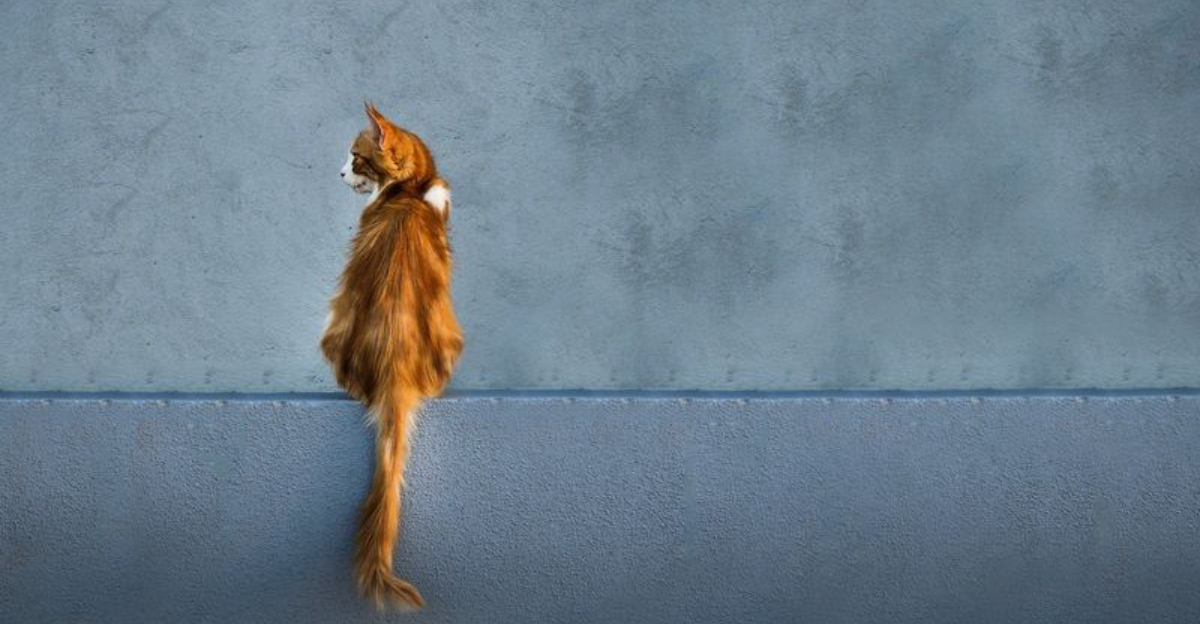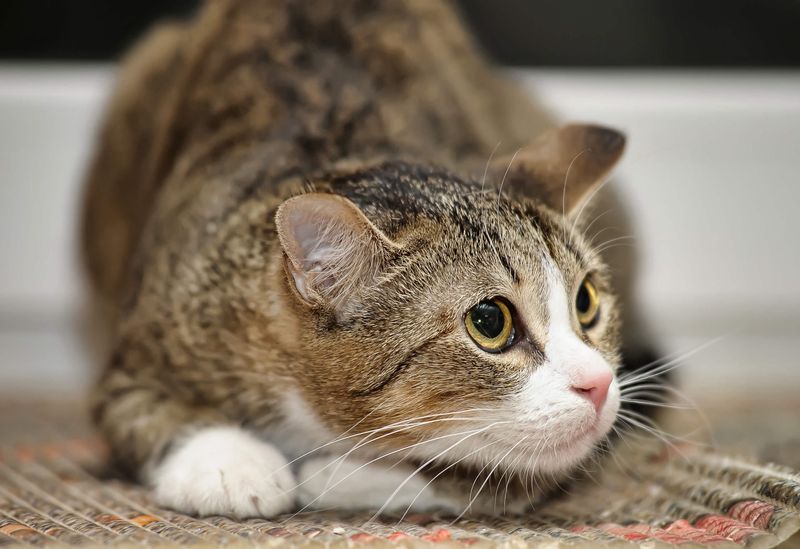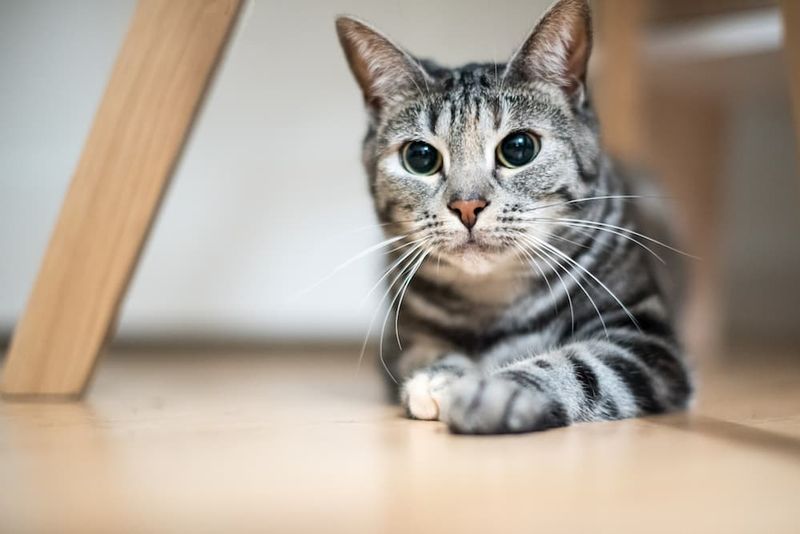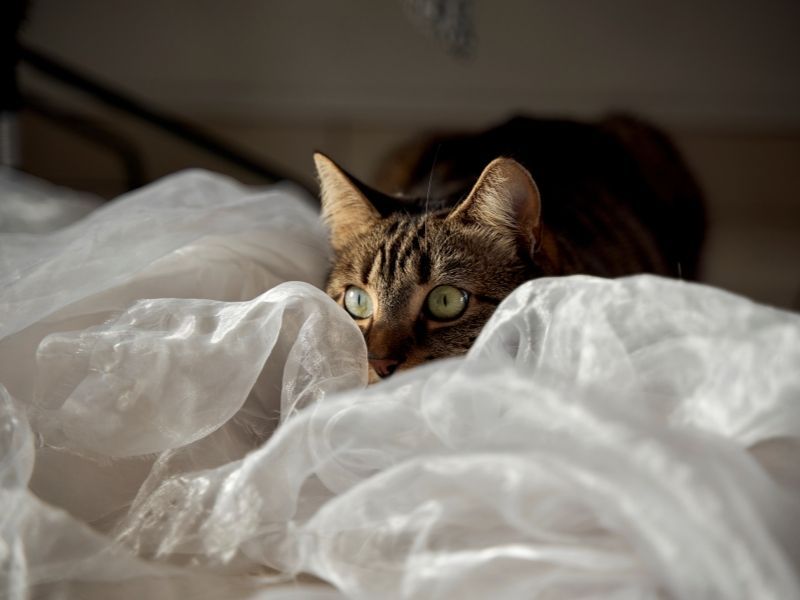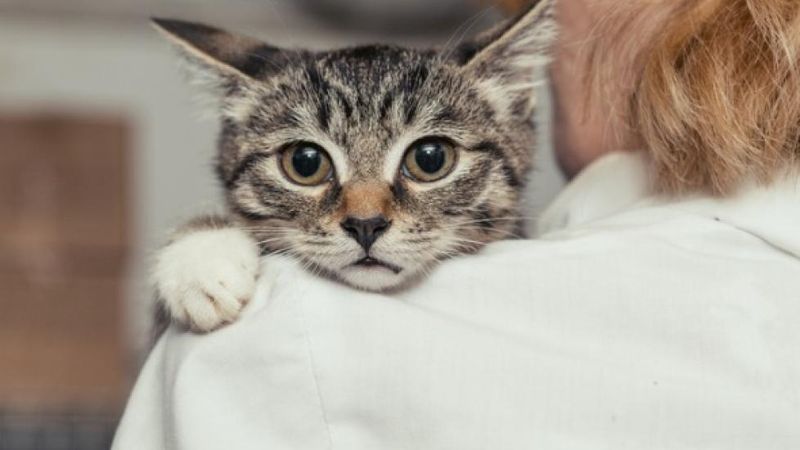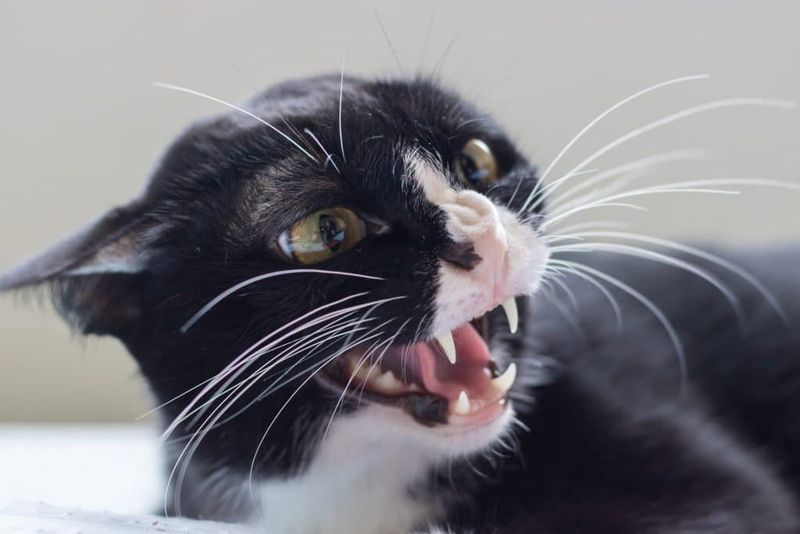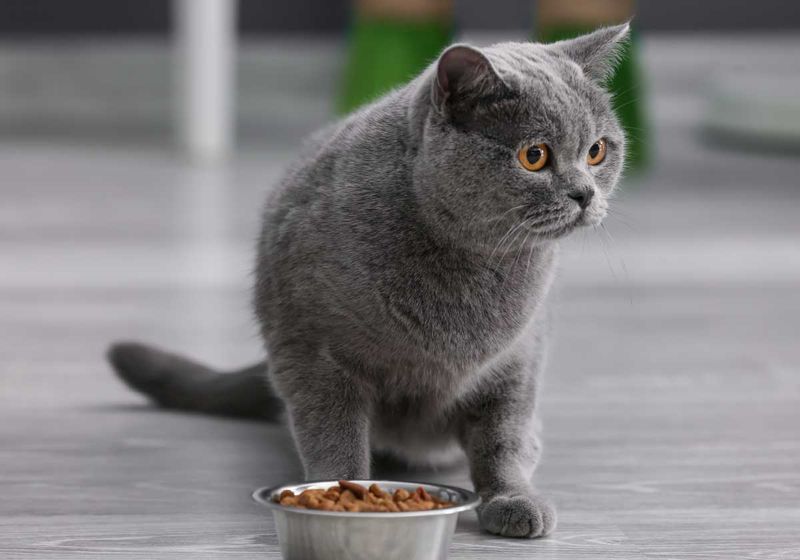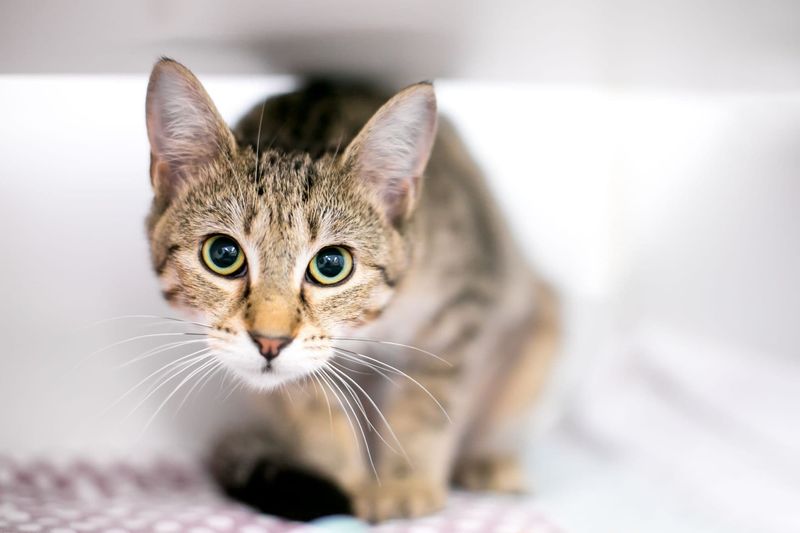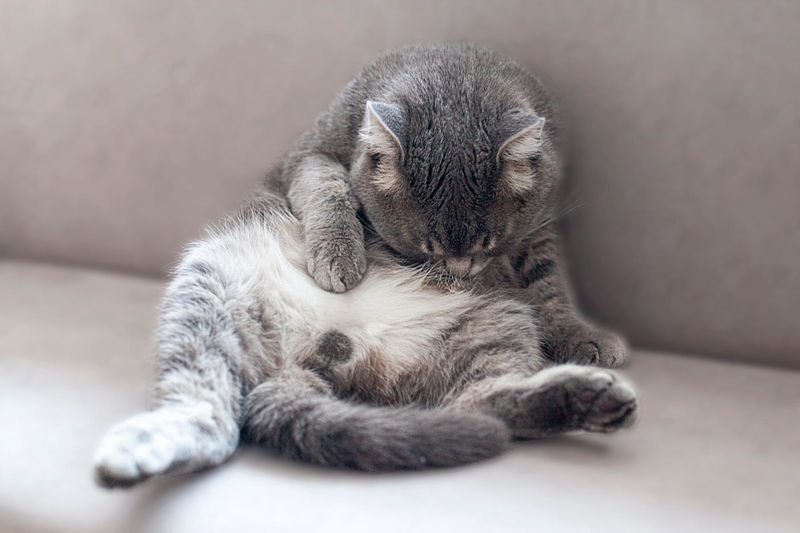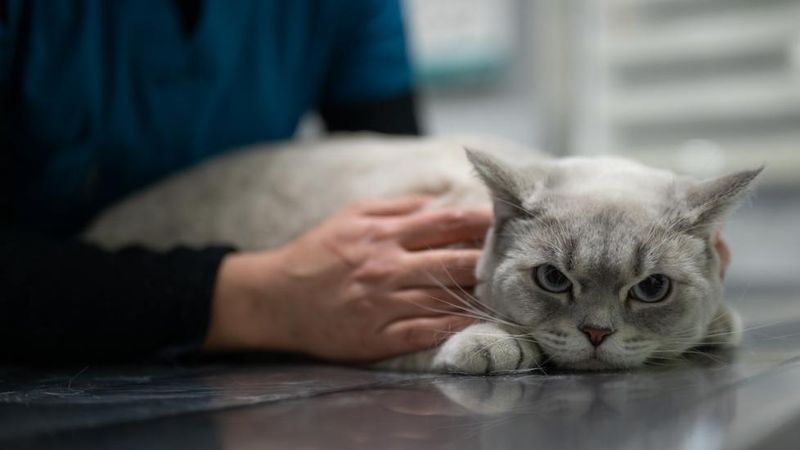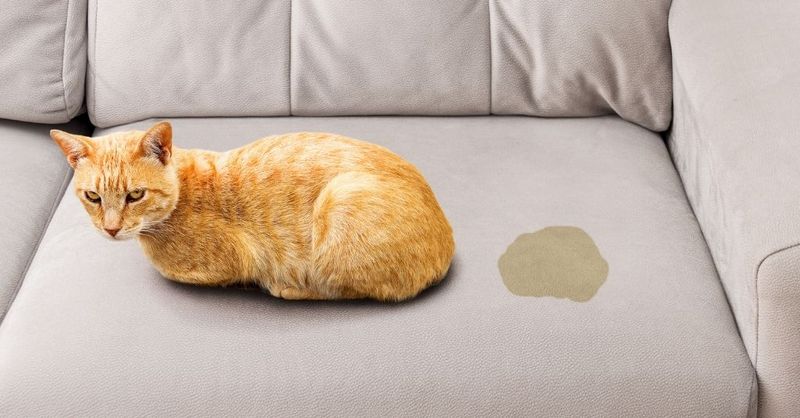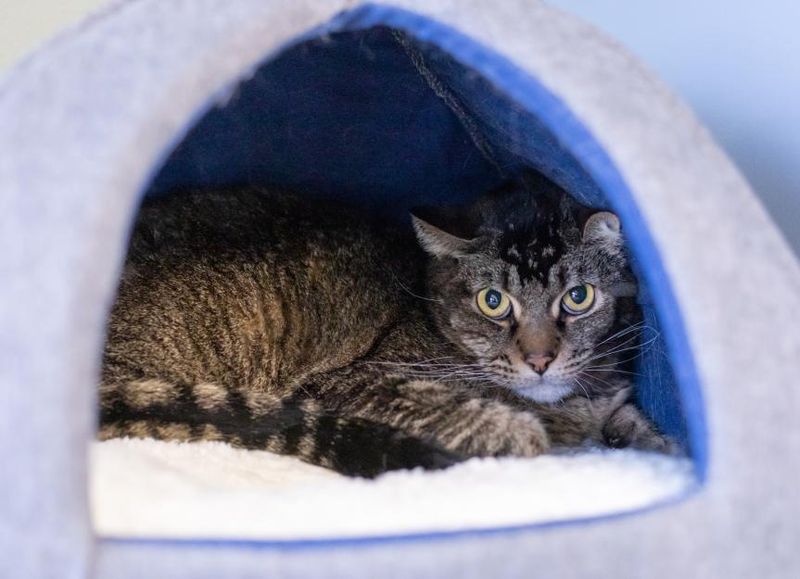📖 Table of Content:
- 1. Flattened Ears
- 2. Dilated Pupils
- 3. Hiding or Avoiding
- 4. Tense Body Posture
- 5. Tail Tucked or Flicking
- 6. Sudden Freezing
- 7. Low Growling or Hissing
- 8. Refusing Food or Treats
- 9. Hypervigilance
- 10. Over-Grooming or No Grooming
- 11. Trembling or Shaking
- 12. Inappropriate Elimination
- 13. Clinginess or Avoidance
Cats, those enigmatic creatures that share our homes, often communicate in subtle ways. Understanding these signals can help us recognize when they are anxious or uncomfortable. While cats may appear aloof, their behaviors often speak louder than words. Here are 13 signs to watch for if you suspect your feline friend is feeling nervous. Each sign provides an opportunity for you to better understand and comfort your pet, strengthening the bond between you and your furry companion.
1. Flattened Ears
The position of a cat’s ears can reveal much about how they are feeling. Flattened ears, often referred to as ‘airplane ears,’ are a clear sign that your cat is feeling threatened or uncomfortable. This defensive posture serves to protect the ears from potential harm. Observe how your cat’s ears tilt sideways, almost touching the head. This gesture often accompanies other signs of stress, such as a tense body or dilated pupils. Recognizing this early warning sign allows you to address whatever is causing your cat distress, whether it’s a new environment, unfamiliar people, or other animals.
2. Dilated Pupils
In bright light, a cat’s pupils should be narrow slits. However, if they are wide and round, it might indicate fear or heightened alertness. Imagine your cat in a well-lit room with dilated pupils, watching intently. This can be a sign that your cat is ready to react to perceived threats. It’s like seeing the world through wide-open eyes, taking in every detail. While dilated pupils can occur during play, if they persist, it may be a sign of anxiety. Pay attention to this subtle yet telling feature of your cat’s eyes to better understand their emotional state.
3. Hiding or Avoiding
If your cat frequently retreats to hidden spots, it might be their way of seeking solace from stress. Picture your cat disappearing under a bed or into the depths of a closet. This self-imposed isolation often signals anxiety or fear. Cats feel safer in confined spaces where they can observe without being seen. While some solitude is normal, consistent hiding might indicate something is amiss. Consider if new changes have been introduced to their environment, as these can disturb a cat’s peace. Offering safe spaces and familiarity can help ease your cat’s nervous tendencies.
4. Tense Body Posture
The way a cat holds its body can communicate their level of comfort or anxiety. Envision your cat crouching low to the ground, muscles rigid, and back arched. Unlike in play, this posture suggests your cat is on high alert, possibly perceiving a threat. The tension in their body is like a coiled spring, ready to react if necessary. This stance might accompany other signs like flattened ears or a flicking tail. Recognizing when your cat displays a tense body posture can help you identify and remove stressors, creating a more reassuring environment for your pet.
5. Tail Tucked or Flicking
A cat’s tail can speak volumes about its emotional state. Imagine your cat’s tail tucked low against its body or flicking rapidly. These are signs that your feline friend might be feeling overwhelmed or anxious. A tucked tail can indicate fear or submission, while a rapidly flicking tail suggests irritation or sensory overload. Pay attention to the context and your cat’s other behaviors. If your usually sociable cat suddenly exhibits these tail movements, consider whether something has changed in their environment. Observing your cat’s tail language can provide important clues about their emotional well-being.
6. Sudden Freezing
Imagine a moment when your cat stops in its tracks, every muscle frozen, eyes wide, and ears alert. This sudden freezing is often a response to feeling trapped or threatened. It’s as if time stands still for your feline friend, and they are calculating their next move. This behavior might occur when they sense an unfamiliar sound or a potential threat nearby. Understanding this instinctual reaction can help you alleviate their fears. Observing your cat’s environment for possible stressors and providing reassurance can help your cat feel more secure and less anxious.
7. Low Growling or Hissing
A cat’s vocalizations can reveal its emotional state. Growling or hissing are signs that your cat is feeling defensive or scared. Picture your cat with an arched back, ears back, and lips curled as it emits these vocal warnings. It’s a clear message to back off and give them space. This behavior is common when cats are confronted with unknown situations or perceived threats. Understanding these sounds as signals of anxiety allows you to adjust the environment or remove stressors, helping your cat feel safer. Acknowledging your cat’s need for distance can strengthen your bond.
8. Refusing Food or Treats
Imagine placing your cat’s favorite treat in front of them, and they walk away, uninterested. Refusing food can be a sign of stress or discomfort. Cats are creatures of habit, and any disruption in their routine can manifest as a loss of appetite. Whether due to environmental changes or unfamiliar sounds, this behavior signals that something is bothering them. It’s crucial to monitor this, as prolonged refusal can affect health. By ensuring a calm and familiar environment, you can encourage your cat to eat, reinforcing their sense of security and well-being.
9. Hypervigilance
A hypervigilant cat is always on the lookout, ready to react to any changes. Picture your cat with wide eyes and perked ears, constantly scanning the room. This state of heightened awareness is a sign that your cat is feeling anxious or threatened. They may flinch at sudden movements or noises, displaying a jumpy demeanor. Recognizing this behavior can help you identify potential stressors in their environment. Providing a calm and predictable atmosphere can help reduce your cat’s anxiety, allowing them to relax and feel more comfortable in their surroundings.
10. Over-Grooming or No Grooming
Grooming is a natural behavior for cats, but over-grooming or neglecting it altogether can signal stress. Imagine your cat obsessively licking its fur, creating bald patches, or, conversely, appearing unkempt. These behaviors can be coping mechanisms for anxiety, similar to humans biting nails. It’s crucial to observe changes in grooming habits, as they reflect your cat’s emotional state. Providing mental stimulation and a stress-free environment can encourage healthy grooming patterns. Recognizing and addressing the root causes can help your cat return to its normal grooming routine.
11. Trembling or Shaking
Seeing your cat tremble or shake can be concerning. Picture your cat lying on a sofa with slight tremors running through its body. This could be a reaction to stress, fear, or a recent traumatic event. The physical manifestation of anxiety is not uncommon in cats, and understanding this response can help you provide comfort. Offering a safe and calm environment with gentle reassurance can help alleviate their stress. Observing your cat closely during these episodes can also provide insights into what might be triggering their anxiety, allowing you to take appropriate action.
12. Inappropriate Elimination
Finding unexpected surprises outside the litter box can be frustrating, but it often indicates stress. Imagine your cat choosing a quiet corner over its litter box. This behavior can be a cry for help, signaling that something is wrong. It might be a response to changes in their environment or a reflection of their emotional state. Addressing the root cause, whether environmental stressors or litter box issues, can help restore your cat’s normal habits. Providing a consistent routine and a comfortable space can alleviate anxiety and encourage appropriate elimination behavior.
13. Clinginess or Avoidance
Cats show their anxiety in diverse ways; some become overly clingy, while others prefer solitude. Picture your cat glued to your side one moment, then hiding the next. This fluctuation between seeking comfort and needing space can be a sign of distress. Understanding your cat’s usual behavior helps interpret these changes. Providing consistency and reassurance can help your cat feel more secure. Whether through gentle attention or respecting their need for space, responding to these cues can strengthen your bond and help your cat feel more at ease.
